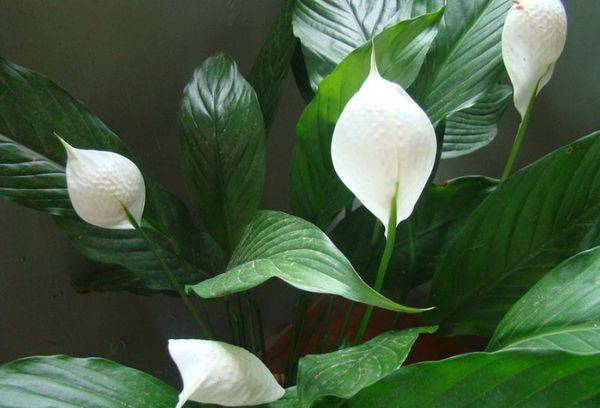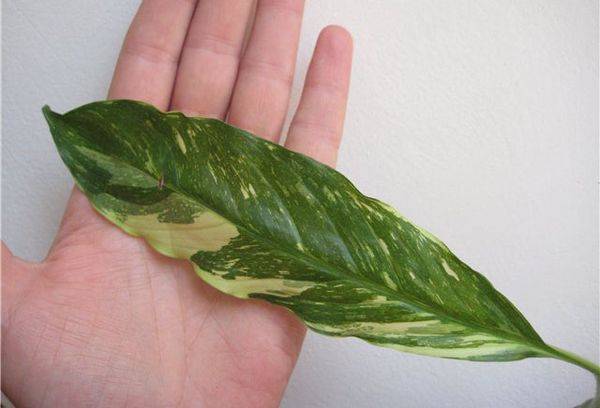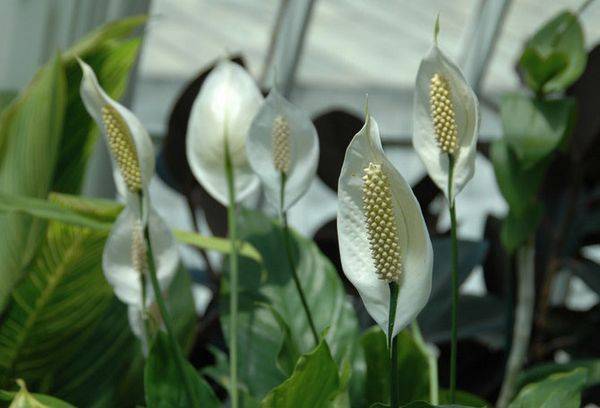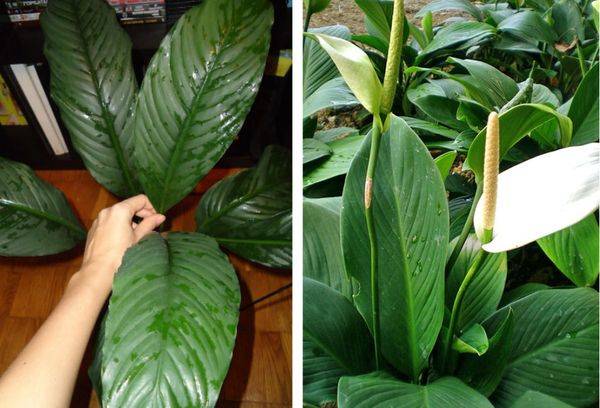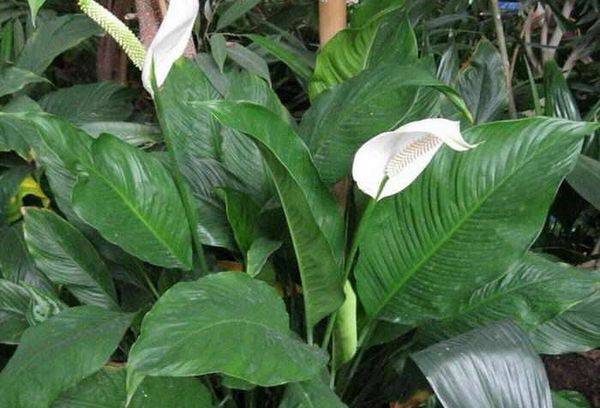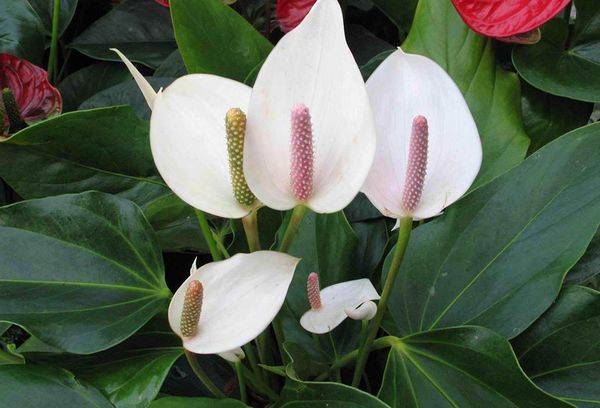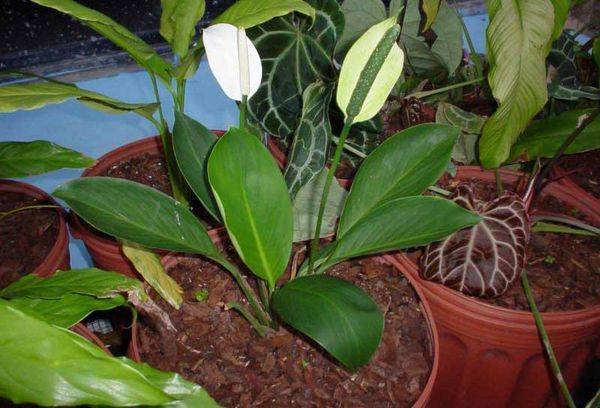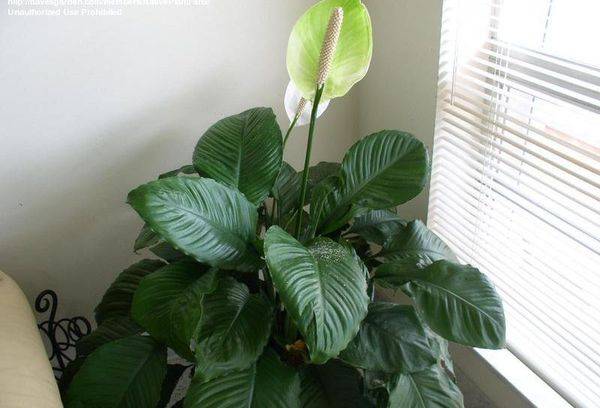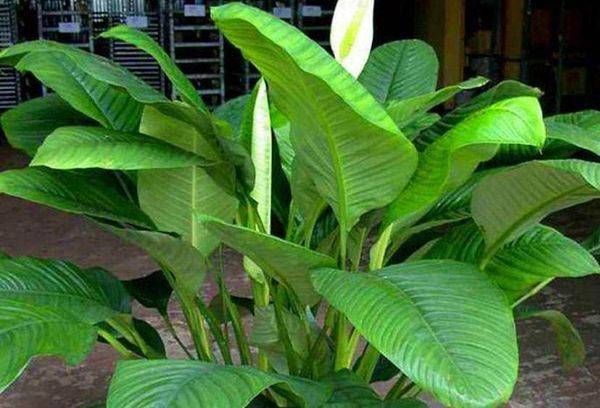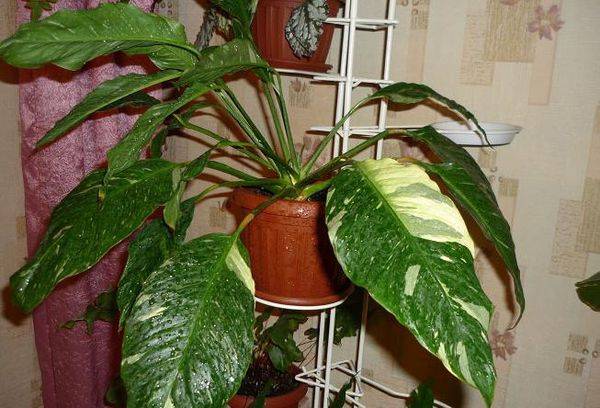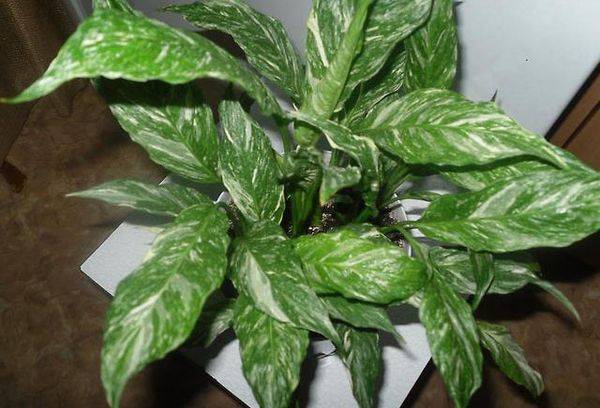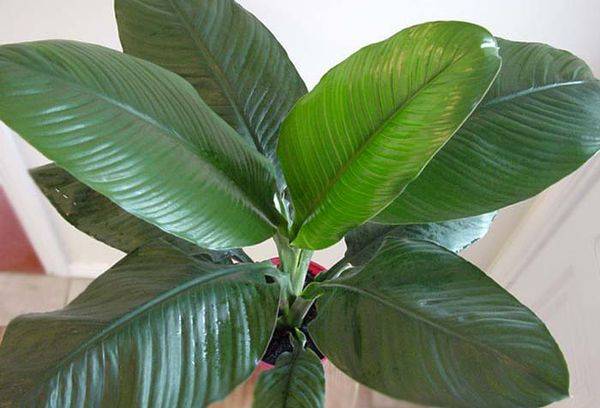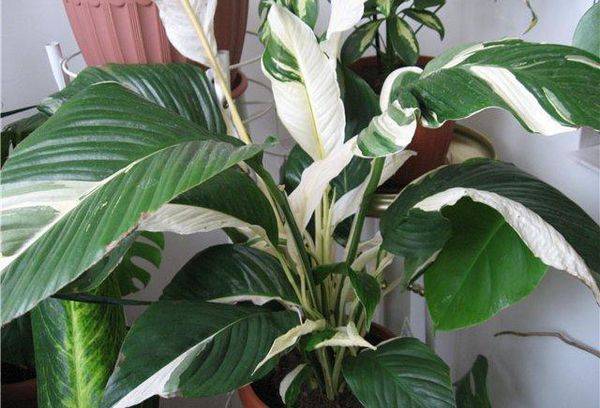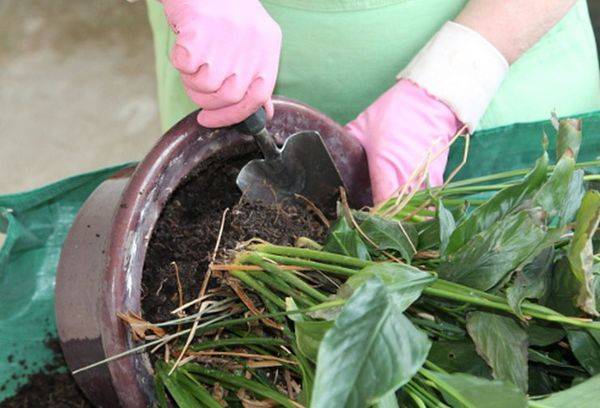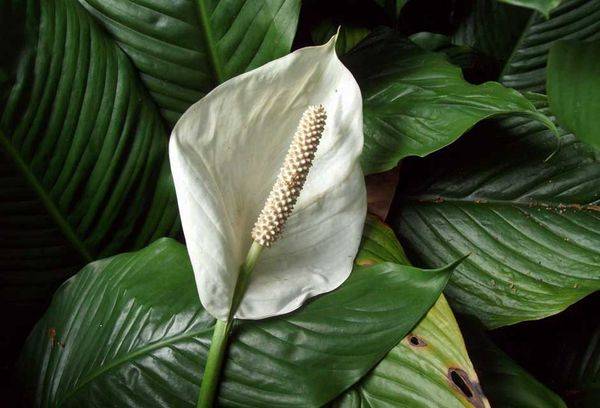How to care for spathiphyllum at home
The plant that young girls and women like to grow in their home is called “feminine happiness”, “white sail” or “female flower”. The official name is spathiphyllum, careful care at home is not required, but if you follow certain rules, the plant will bloom profusely and really attract love and happiness to the house.
Description
Spathiphyllum - A tropical plant that naturally grows in the forests of South America along streams, rivers, and swamps. For this reason, when growing a flower at home, it is necessary to create a microclimate that is as close to natural as possible. The size of the bush is from 15 to 100 cm, depending on the species.
Leaves grow in a bunch directly from the rhizome, there are no branches at the spathiphyllum. Leaf plates are oval, with different species they have different lengths. Because of the veins, the leaves are embossed and often wavy at the edges.
Spathiphyllum forms an ear with bisexual flowers, at the base of the inflorescence is surrounded by a veil of white or greenish tint, oblong-oval in shape, with a sharp end. The plant blooms for 3-5 weeks, with proper care - twice a year: winter-summer or spring-autumn. Under ideal conditions of detention, “happiness” will blossom in March-September.
Tip
To make new inflorescences appear faster, cut off the fading.
Kinds
Currently, about 45 species and varieties of spathiphyllum are known. All of them differ in the size of the bush, the color of the ears and bedspreads. There are hybrids that are more hardy and bloom throughout the year.
The most common types:
- Spathiphyllum adorable has dark green, elongated leaves with a pointed tip and long strong petioles. The inflorescence is surrounded by a veil of a greenish-white hue that resembles a flag in shape, therefore it was popularly called the “flagolist”. It blooms profusely from April to June, while a large number of flowers are formed. If plant care is good, then the flowers appear twice a year. The bush grows quite large.
- Spathiphyllum spoon-shaped reaches one meter in height. The leaves of the plant are oblong-elliptical in shape, 30-40 cm long and 15-20 cm wide, dark green, wavy at the edges, with a glossy surface. Petiole strong and long. The inflorescence is white, the oval-shaped bedspread is long.
- Spathiphyllum wallis differs in unpretentiousness to cultivation conditions and leaving, feels good in partial shade. Plants of this species are not higher than 40 cm, there are dwarf varieties. The inflorescence is located on a long peduncle, the cover is narrow, white. It blooms profusely.
- Spathiphyllum profusely flowering reaches a height of not more than 60 cm. Leaflets are oval, lanceolate, with a velvety surface, green, in the middle of a lighter shade. On the underside of the sheet, a shade of green is lighter, matte. It differs in dense flowering for 3-4 weeks.
- Canniferous spathiphyllum has large ovoid leaves of bright green color with a glossy surface. The inflorescence is yellow, fragrant, with a white-green veil. It has a long flowering period. Quite a rare guest in the rooms.
- Spathiphyllum Mauna Loa is the most popular species, reaches a height of about 70-80 cm. The leaves are dark green, wide, old - they wilt, but do not dry out, making the bush look lush. The inflorescence is milky in color, the petal-veil is oval, white. Flowers of this species are often used in bouquets.
- Spathiphyllum heliconious grows to one meter in height.The leaves have an oblong shape and a glossy surface, oval, pointed at the ends, green, with wavy edges. In length - up to 50 cm, in width - 25 cm. The flower stalk is high, at its end there is a large thick white inflorescence with the same large blanket of white color. Over time, the core begins to darken.
- Spathiphyllum Caiti - up to 70 cm in height. Leaflets are soft, green with yellow fuzzy splashes. The peculiarity of the species is that it perfectly tolerates excess moisture.
- Spathiphyllum Domino - one of the most beautiful among all decorative species due to the colorful coloring of the leaves. The inflorescence is located on a high pedicel, the core has a yellow hue, which over time turns green. The bedspread is large, white.
- Spathiphyllum Sensation - a giant among other species, as it can grow in an apartment up to one and a half meters. The leaves are oval, oblong in shape, with tall stalks, ribbed over the entire surface, pointed at the ends, green. In ideal conditions, leaf blades grow in length to significant sizes - 90 cm, with a width of 40 cm. The inflorescences are large.
- Spathiphyllum Picasso It was withdrawn relatively recently. A feature of the species are leaves, which can be of different colors. For example, one leaf is dark green, the other is white, or these colors mix on one leaf plate. The species is best grown in partial shade or in good light conditions.
Care
Since tropical forests are the birthplace of spathiphyllum, even at home it needs bright but diffused light, as in the understory, and a lot of heat.
Spathiphyllum feels best in partial shade, for example, on the east window. If the flower is in complete shade, then its leaves become dark green; spathiphyllum will not bloom in such conditions. Direct sunlight provokes burns.
The temperature will be optimal in the spring and summer months - from +22 to + 24 ° C, the plant does not tolerate extreme heat. In winter, the thermometer in the room should not fall below + 16 ° C.
What is difficult to overdo is with air humidity. Spray the plant more often, put it in a pan with wet pebbles or expanded clay, arrange a warm shower.
Tip
purityis.decorexpro.com/en/ recommends avoiding droplets of water on flowers if the spathiphyllum blooms.
Watering the plant is necessary only with well-settled (at least 12 hours) or boiled water with a minimum chlorine content. It will not be superfluous to slightly acidify the water with vinegar (for 1 liter, take 5 drops of vinegar and mix thoroughly). Water the plant abundantly in summer, less often in winter. Black spots on the leaves indicate violation of the watering regime, if the errors are not corrected in time, the flower will disappear. Excess and lack of moisture are equally harmful for the plant, between the irrigations the soil surface should dry out.
Make top dressing once every 3 weeks with complex mineral fertilizers intended for decorative indoor plants. The appearance of excess nutrients is indicated by the appearance of brown spots on the leaves.
Tip
All top dressing should be done only after plentiful watering.
Soil is of paramount importance when growing spathiphyllum, as an improper soil mixture provokes yellowing of the leaves. The optimal mixture is taken in equal proportions:
- sheet land;
- river sand;
- peat;
- sphagnum.
Reproduction and transplantation
During the spring transplant, the plant can be propagated by dividing the bush. At the same time, 2-3 leaves should remain on each part.
Plant the separated parts in the purchased substrate, designed specifically for aroid, or in the self-made soil.
Soil components must be taken in approximately equal amounts:
- turf land;
- peat;
- humus;
- leaf soil;
- sand (or perlite).
When transplanting into acquired universal soil, be sure to add coconut fiber and charcoal to it.
If there are parts without roots when dividing the bush, then root them first in moist perlite or sand. To create increased humidity, cover with a plastic bag or place in a greenhouse. Open, moisten and ventilate plants periodically. After the roots appear, transplant into permanent soil.
The transplant is carried out by transshipment, as this allows not to injure the root system. At the bottom of the pot, be sure to lay out a layer of drainage, since spathiphyllum is sensitive to stagnation of moisture.
Tip
The new flowerpot should be a couple of centimeters larger than the previous one. If the capacity is very large, this will slow down the flowering or there will be no flowers at all until the root system fills the entire pot.
Transplant young plants annually, more adults - once every 3-5 years. Between transplants, renew the topsoil in the pot every year.
Diseases and Pests
Most often, the plant is affected by a mealybug, aphids, scale insects, and spider mites. Pests transmit viruses and fungi.
Treatment with folk remedies:
- wash off insects with soapy water;
- remove with tincture of tobacco leaves, citrus peels or onion husks.
If the lesion is large-scale, it is better to use insecticides. Spray the flower with a solution prepared in accordance with the instructions for use.
Recommended Insecticides:
- Fitoverm;
- Bona Forte;
- Actara;
- Bioinsecticide.
Black spots on the leaves indicate a soot fungus. Rinse the leaves with warm water and green or laundry soap in the shower. Rinse off the soap with clean, warm water. After several procedures, the soot fungus will disappear.
White plaque that appeared in the upper part of the leaf indicates the defeat of powdery mildew. If plaque is only at the bottom of the leaf plate, then the outcome of the treatment will be favorable. Powdery mildew above and below indicates that things are bad. An effective means of combating the disease is fundamentalazole. Use the drug in accordance with the instructions for use.
Useful Tips
The recommendations of experienced gardeners will help to grow a very beautiful plant at home, flowering abundantly and for a long time, and also to identify the cause of the problems that have arisen:
- Most often, gardeners are interested in why the plant does not bloom. Usually this is due to a too spacious flowerpot - the plant will not bloom until its root system fills the container completely. Transplant spathiphyllum into a smaller pot and hold for several weeks at a temperature of +12 to + 15 ° C. In some cases, there is no flowering due to violation of the rules of care.
- The plant begins to turn yellow due to irregular watering and drying out of the soil. If this happens, do not immediately water too heavily, start to soak the dried soil a little, gradually increasing the amount of water. Sometimes the cause of yellowing is insufficient humidity. In this case, wipe the leaves with a damp sponge and start spraying the flower. Not bad - put a saucer with wet expanded clay next to the pot. In some cases, yellowness indicates an invasion of pests.
- Blackening of the leaves of spathiphyllum is a consequence of the death of the roots. This often happens due to waterlogging of the soil or spraying at low air temperature. Remove the plant from the soil and inspect the roots, remove the rotten ones, and transplant what is left into fresh soil.
- In some cases, blackening indicates an unbalanced diet - there are too many or insufficient nutrients. The blackened and drying edges of the leaves indicate a lack of phosphorus and nitrogen.
- The tips of the leaves of the plant begin to dry under the simultaneous influence of two factors: lack of nutrients and dry or very cool indoor air. Eliminate the imperfections and the flower will gradually recover.
- Drooping leaves indicate a lack of moisture.Spray the plant, place a tray with wet sand or moss. The roots should be constantly moist. Leave the water in the pan after watering; sometimes it is useful to grow a flower in a flowerpot immersed 1/5 in water.
